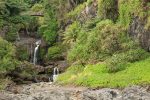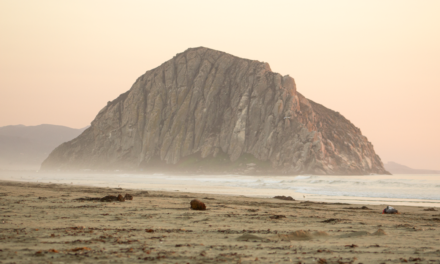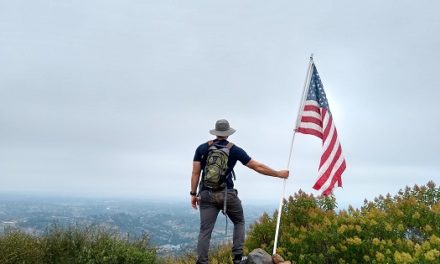Seven Sacred Pools (‘Ohe’o Gulch) Hiking Trail Guide
No trip to Maui is complete without visiting Haleakala National Park. Rising 10,023 feet above the ocean, the dormant volcano rises above sea and composes the bulk of the land mass on Maui. The national park sits atop the summit and extends down a narrow sliver of the mountain to the eastern flank. There are two distinct districts within the park: the Kipahulu and Summit district. The summit district encompasses all activities near the top of Haleakala. The Kipahulu district lies on Maui’s more remote eastern side of the mountain. This district features usually rough coastal areas and lush tropical slopes with waterfalls and is where this hike is located.
The Seven Sacred Pools hike lies at the bottom of a deep canyon known as the Ohe’o Gulch. Carved out by thousands of years from the Pipiwai stream and persistent floods, the bottom of the gulch features several pools formed by a set of cascading waterfalls. Over time the strength of the water formed a set of seven pools at the bottom of each waterfall. Despite the interesting name, the Seven Sacred Pools term was actually coined by what was then called the Hotel Hana Maui. The actual name is Pools of ‘Ohe’o but the Seven Sacred pools name was given as a marketing plot for tourists (1).
As for the hike, the Seven Sacred Pools trail is a relatively easy lollipop type of trail. The trail begins at the Kipihulu Visitor Center and leads down an incline of about one hundred feet to a black sand beach. At the beach the Pipiwai stream enters the ocean and from here the cascades of the Pipiwai stream and Ohe’o gulch can be seen. Some visitors leave the main trail and scramble up the gulch towards the pools. It’s not uncommon to see people swimming in the pools. However, heavy rain is a common occurrence in the higher elevations. Although it may not be raining at the coast, rain in the higher elevations can cause the stream to flood. People have died here from flash floods. The National Park Service discourages people from swimming in these pools (2).
HALEAKALA HISTORY
In Hawaiian, Haleakala means, house of sun, which references the Hawaiian deity, Maui. . According to Hawaiian culture, Maui wrestled with the sun at the top of this volcano. The legend starts after Maui’s mother complained that there wasn’t enough light during the day to complete all her tasks. Maui took to the top of Haleakala and captured the sun with a hook and fishing line and secured him to a tree. The sun begged to be released but Maui would only do so if the sun promised to move more slowly across the sky and provide more daylight.
Legends aside, it’s the views from the summit of Haleakala that attract so many people. The pristine air is often clear, and to be honest, sunsets can be just as beautiful as sunrises from this location. However, sunsets are more often obscured by cloudy afternoons in the tropics. From the top of the mountain there will be 360-degree views. To the east, the mountains of Mauna Kea, Mauna Loa, and Hualalai on The Big Island will be visible. From sea level, Mauna Loa is also actually the tallest mountain in the world. To the west will lie the islands of Kaho’olawe, Lanai, and Molokai’i. To the east white fluffy clouds will line the horizon as the Pacific Ocean stretches out as far as the eye can see. As the sun rises it quickly paints the neighboring mountains and red volcanic craters of Haleakala in beautiful saturated colors. All while, the nearly eleven foot thousand mountain casts its shadow below (3).
On A Personal Note:
For the most part, the Pipiwai stream is generally pretty gentle. As was the case when my wife and I visited these falls. The flow of the stream was very mild. If you’re unfamiliar with signs to look for in regards to a possible flash flood, it’s advised to stay away from the stream. Because of the ease of access, this is one of the most popular destinations in the Kipahulu District of Haleakala National Park. Keep in mind: There is no food or gas available in the park. Emergency services are also about an hour away. Plan accordingly.
Looking for another hike nearby? I highly suggest the Pipiwai trail which leads in the opposite direction up the mountain from this trail. This hike winds approximately four miles through tropical rainforest along the ridge that follows Ohe’o gulch from what the Pipiwai stream flows through. The landscape along the hike resembles something out of a Jurassic Park movie. Included along this trail is a bamboo forest, a waterfall viewpoint of Makahiku falls, and the towering Waimoku falls.
Sources:
1. N.a. “Pools of ‘Ohe’o (aka Seven Sacred Pools.” Maui Guidebook. Maui Guidebook.com, LLC. Pools of ‘Ohe’o (aka Seven Sacred Pools) | Maui Guidebook Accessed 24 August 2021.
2. N.a. “Kipahulu District.” National Park Service. U.S. Department Of The Interior. https://www.nps.gov/hale/planyourvisit/kipahulu.htm. 24 May 2021. Accessed 10 July 2021.
3. N.a. ” Short Hike To Makahiku Falls.” National Park Service. U.S. Department Of The Interior. https://www.nps.gov/thingstodo/short-hike-to-makahiku-falls.htm. 18 December 2020. Accessed 10 July 2021.
- Overall Difficulty 10%
- Overall Views 80%
Seven Sacred Pools Trail Quick Facts:
- Max elevation: 145 feet.
- Elevation Gain: 98 feet.
- Estimated Distance: 0.6 miles.
- My Actual Distance: 0.6 miles.
- Estimated Time: 15 to 60 minutes.
- My Time: 15 minutes.
Seven Sacred Pools Trail Directions:
Open in maps. Price to enter is the cost of admission to the national park. An America The Beautiful Pass will also work. Parking is at the Kipahulu Visitor Center. There is ample parking but the parking lot can fill up. The trailhead is at the parking lot. The Hana Highway is a narrow two lane road so please be courteous and drive safe. Don’t forget that people call this place their home.
Seven Sacred Pools Trail Pictures:
- The main parking lot for the Kipahulu District.
- The small visitor center.
- The trails are clearly marked. Follow the trail
- The trail immediately curves to the right towards the coast.
- The trail eventually leads to the ridge above Ohe’o gulch and the Pipiwai stream.
- Overlooking Ohe’o gulch, the Pipiwai stream, and the Seven Sacred pools from above the trail.
- Looking out from the trail towards the rough eastern Maui coastline.
- The Ohe’o cascades from the shoreline along the Pipiwai stream.
- A view of one of the cascades from higher up on the trail.
- A closer shot of one of the cascades of the Seven Sacred Pools
Who The Seven Sacred Pools Hike Is For:
Novice Hikers: This is a perfect hike for hikers within this category. The trail is relatively mild and offers great views of the Kipahulu District with relative ease.
Advanced Hikers: The views are worth the stroll but you will feel more accomplished also doing the Pipiwai and Waimoku Falls trail.
Expert Hikers: If you spend all your time in the car coming this distance check out the Pipiwai trail mentioned above. The views along the trail are amazing. If you’re looking for more to do, enjoy some of the other trails nearby and along the Road to Hana such as the Twin Falls Hike.
It’s always a good idea to be aware of what type of hiking level you’re at.
Best Time Of Year To Hike The Seven Sacred Pools:
Generally speaking, there is no bad time of year to hike this trail. Temperatures and weather are pretty consistent throughout the year with mild fluctuations between winter and summer. This portion of the island does receive a lot of annual rainfall. There can be no rain where the trail is located and rain in the higher elevations that cause flash flooding where the trail is. Rain and drizzle are common so come with those expectations. After all, there is a reason for the dense rainforest and persistent streams. Please be aware of the weather conditions in the area.
It’s always a great idea to check the weather before a hike.
Seven Sacred Pools Trail Conditions:
The Seven Sacred Pools trail down to Ohe’o Gulch is in generally great condition and maintained by the National Park Service and local volunteers. The hike begins right at the parking lot for the Kipahulu Visitor Center. Signs are clearly marked. The trailhead for the Pipiwai and Waimoku Falls hike starts at the same area so be sure to follow the correct signs. Just remember, if you’re heading to the coast you’re going in the right direction.
From the parking lot the trail follows an immediate path to the right towards the coast. This is a lollipop trail so at one point you will notice a fork in the trail. The decision is yours to make as to left versus right. An immediate right leads down a path to the black sand beach where the mouth of the Pipiwai stream meets the Pacific Ocean. From the coast there will be great views of the eastern coast of Maui as well as a direct look up the Ohe’o Gulch. When the Pipiwai has strong flow the waterfalls will be very pronounced.
From the coast follow the trail back up a ridgeline right above the Ohe’o gulch. The ridge will provide a birds eyed view of the pools created by the Pipiwai stream. From there the trail will curve back to the parking lot to the visitor center. Some people will hike up the gulch and scramble the lava rocks up the Ohe’o gulch to swim in the pools. Doing this discouraged by the National Park Service. In fact, people have been caught in flash floods and have been swept out to sea or have been killed doing so. Wade in the pools and travel up the gulch at your own risk.















